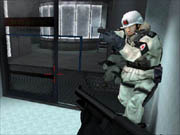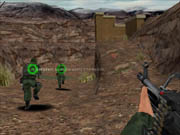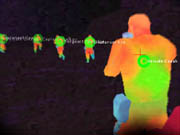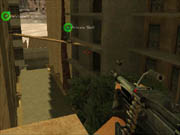Global Operations, a putative Counter-Strike killer by Barking Dog Studios, is kind of like having to eat a banana split with your hands--just because it's a little sloppy doesn't mean it isn't still good. The game is primarily a team-based tactical shooter, combining Counter-Strike's system for cash rewards and equipment purchases, Rogue Spear's real-world settings and large weapon selection, and Return to Castle Wolfenstein's character classes and objective-based maps. For good measure, the developers have added some innovative ideas of their own to this mix. The game did ship in an unpolished state and suffers from demanding bandwidth requirements and a severe lack of servers. However, these problems are generally overshadowed by the simple fact that when everything comes together, Global Operations is one of the deepest and most satisfying multiplayer tactical shooters currently available.

To one-up its arch-nemesis, Counter-Strike, Barking Dog promised Global Ops would include a single-player game along with the expected multiplayer mode. The best that can be said about what resulted from that promise is that Barking Dog didn't lie: Global Ops does indeed include a single-player game. It's a linear progression through the 13 multiplayer missions with each of the 15 other players controlled by a bot. The bots have their moments, but for the most part they're not especially helpful when they're on your team, nor are they particularly dangerous when they're on the other side. Every instance where they appear to have some idea of what's going on is eclipsed by an episode in which they fail to use the equipment of their character class, ignore your commands, make crazy choices while pursuing a map's objectives, or simply get stuck on something, at which point the game helpfully warps them into the clear. The bots aren't completely ineffectual. But the single-player game is more of a slightly enhanced training mode than a full-fledged campaign. Anyone thinking about purchasing Global Ops primarily for its single-player experience is strongly advised to stay away.
Like in Counter-Strike, each round in Global Operations begins with you purchasing equipment. However, you must also pick a character class, like in Wolfenstein. The seven classes include commando, heavy gunner, recon, medic, sniper, demoman, and intelligence officer. Each one varies in its starting cash, access to items, carrying capacity, and proficiency with the different types of weapons. Most of the classes are pretty self-explanatory. The commando is an all-around grunt who can use a wide range of weapons, the heavy gunner carries the big machine guns useful for laying down suppressing fire, the demoman can plant and defuse explosives, the medic can heal wounded teammates, and the sniper is pretty much just that. The intelligence officer is a noncombat role. He has an overhead view of the mission area from which he can set waypoints. He can also access first-person views from anyone on his team and access views from cameras placed throughout each level. It's a lot like the commander role in Tribes 2. And like with the commander in Tribes 2, nobody appears to be interested in playing that role.

The recon unit, however, is possibly the game's most successful innovation and has turned out to be very popular thus far. A player on recon is automatically equipped with a life-signs detector. When the detector is activated, every enemy unit, friendly unit, and moveable object within a wide range appears onscreen as a symbol whose size and position represent its relative distance from the recon player. This is regardless of how many intervening walls there may be. The great part is that teammates in the vicinity of the recon unit receive this information as well. This has the dual effect of inspiring teamwork and reducing the viability of lone-wolf camping. A squad consisting of a recon unit, a medic, and a couple of gunners is a formidable force. A complementary little innovation is that large-caliber guns can fire through thin walls. It's incredibly satisfying to shoot an opponent hidden behind a flimsy barrier after your recon unit paints him for you.
Rather than the short three- or four-minute rounds and one-death-and-you're-out system of Counter-Strike, Global Operations employs longer 10- to 30-minute rounds with dead players respawning as a group every 90 seconds or so, as in Wolfenstein. This works well with the equipment-purchasing feature. When you die, you collect money for kills, assisted kills, the length of time you managed to stay alive, and various other class-oriented actions. You also drop your weapons wherever you were shot. This sets up some interesting decisions--mainly, should you spend money now or save it and try to pick up some dropped equipment in the level?
The 13 levels included in Global Operations are all excellent. The objectives include hostage rescue, item retrieval, object destruction, and assassination, with many of the levels incorporating multiple goals. Each level is big, features well-placed choke points, and usually includes multiple paths to any given point, including shortcuts that can be opened up through the use of explosives.

Global Ops uses the LithTech engine, and though the environments are a little blocky, they're more than serviceable. The game also has some really well executed visual effects, some of which actually enhance the gameplay. For instance, tear gas causes your view to smear and periodically go black, simulating how your character is trying to blink the irritant out of his eyes. The character models and animations are also well done. Shooting someone in the head will cause him to clutch his face as he drops, while shooting him in the back will knock him forward as he reaches around behind him. This only occurs on killing shots, however--a nonlethal hit unfortunately doesn't provide much visual feedback. This can be frustrating when combined with the game's sometimes-unpredictable damage model. Sometimes an enemy will go down after just one or two hits, as you'd expect. At other times, you'll seemingly have to unload entire clips of ammunition to get someone to drop.
The sound effects are outstanding. Each of the game's 33 real-world weapons has a specific and often immediately recognizable sound. Levels all feature a lot of subtle ambient noise that really picks up any slack in the details of the environmental graphics. There are also a huge number of different footstep effects corresponding to different floor materials. As with some of the visual effects, the clever use of sound actually affects gameplay. The best example of this is that nearby explosions briefly cause a ringing in your ears and a general muting of sound that can impact your ability to hear enemies approaching.
Global Operations does have a few considerable flaws. First among them is a dire lack of servers. This can be partially attributed to the game's newness, but some of the blame needs to be placed on the design of the game itself. Server requirements are steep: According to the scant information in the readme file, a full T1 line is needed to host a 16-player game. Servers must also be dedicated, and only one server instance can be run on a given machine. There's also no Linux server port at this point, though one is promised. Even when registering a good ping, the game is virtually unplayable when connected to an underpowered server, and even on decent servers, in our experience, it's incredibly choppy if the client has anything less than a DSL or Cable connection. There are currently only about 50 servers running at any given time, of which maybe six or seven were playable for us. On those, though, everything ran perfectly smoothly. LAN play is also smooth, but every player needs a unique CD key to join in.

In spite of the attention to detail apparent in the game's many neat little touches--for instance, defusing a bomb involves actually figuring out which wire to cut, meaning if you're in a hurry, you can cross your fingers and take a guess--it seems as if a few elements were either glossed over or simply not included. There's no voting system, for example--if someone on your team decides to concentrate on peppering your respawn spot with tear gas, there's not much recourse. There's not a lot of detailed information about the characteristics of the many weapons, either, nor any place to test-fire them at your leisure. A shooting range of some sort would have been great, considering all the different hardware available. And short of starting your own dedicated server on a separate machine, there's no easy way to explore the levels without opposition in order to learn them.
So here's a recap of the requirements: If you don't care about the single-player game, if you have a high-speed Internet connection, and if you can find a good server, then Global Operations is great. It'll be a shame if not enough people meet these requirements, because Global Ops is an innovative team-based shooter that deserves an audience.